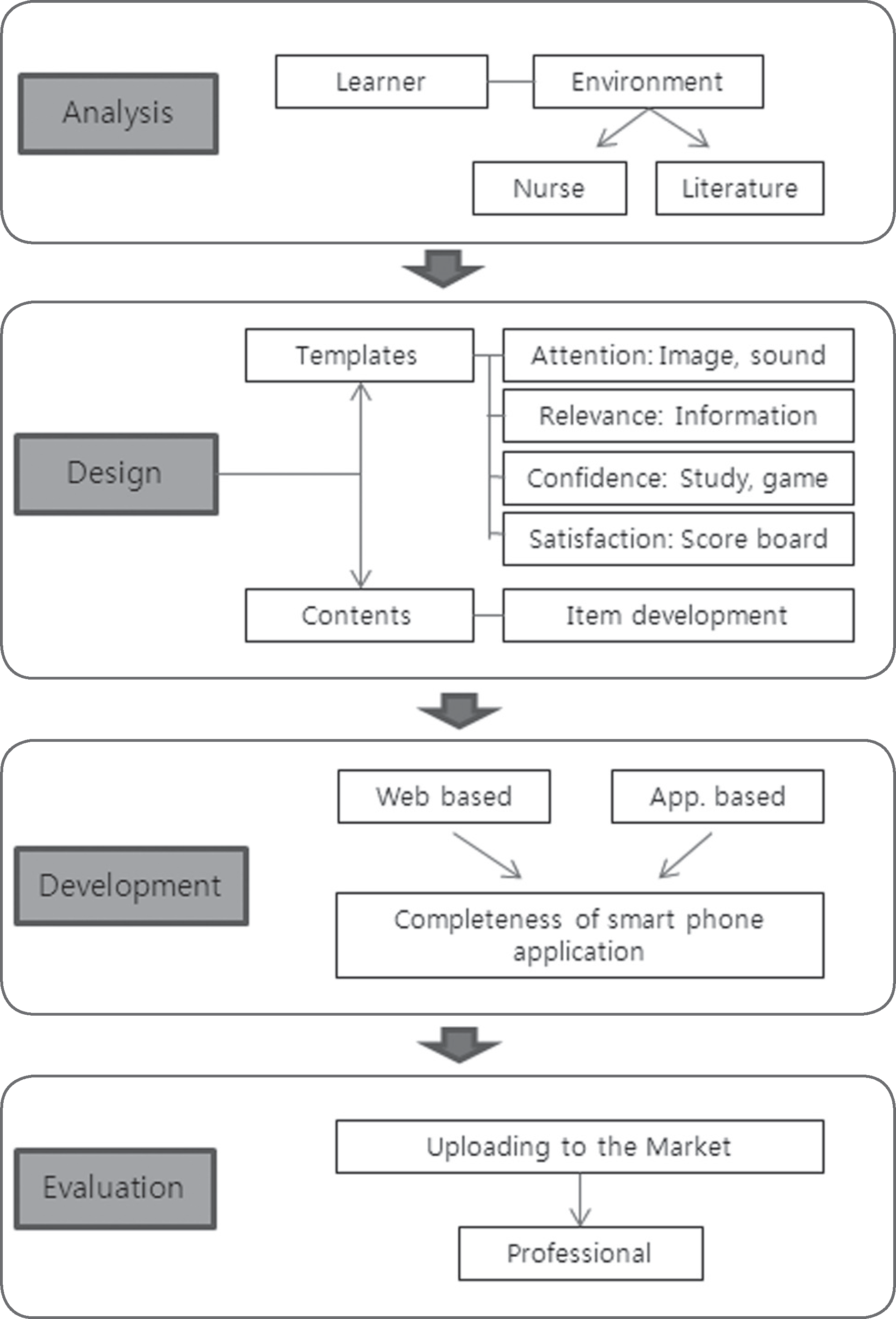Abstract
Purpose
This study was done to develop and evaluate a drug dosage calculation training program using cognitive loading theory based on a smartphone application. Calculation ability, dosage calculation related self-efficacy and anxiety were measured.
Methods
A nonequivalent control group design was used. Smartphone application and a handout for self-study were developed and administered to the experimental group and only a handout was provided for control group. Intervention period was 4 weeks. Data were analyzed using descriptive analysis, χ2-test, t-test, and ANCOVA with the SPSS 18.0.
Results
The experimental group showed more ‘self-efficacy for drug dosage calculation’ than the control group (t= 3.82, p< .001). Experimental group students had higher ability to perform drug dosage calculations than control group students (t= 3.98, p< .001), with regard to ‘metric conversion’ (t= 2.25, p = .027), ‘table dosage calculation’ (t= 2.20, p = .031) and ‘drop rate calculation’ (t= 4.60, p< .001). There was no difference in improvement in ‘anxiety for drug dosage calculation’. Mean satisfaction score for the program was 86.1.
Go to : 
References
Aspden P.., Wolcott J. A.., Bootman J. L.., Cronenwett L.R. 2007. Preventing medication errors: Quality chasm series. Washington DC: National Academy of Sciences.
Bandura, A. 1978. Self-efficacy: Toward a unifying theory of behavioral change. Advances in Behaviour Research and Therapy. 1:139–161. http://dx.doi.org/10.1016/0146-6402(78)90002-4.

Bliss-Holtz, J. 1994. Discriminating types of medication calculation errors in nursing practice. Nursing Research. 43:373–375. http://dx.doi.org/10.1097/00006199-199411000-00010.

Brown D.L. 2002. Does 1 + 1 still equal 2? A study of the mathematic competencies of associate degree nursing students. Nurse Education. 27:132–135.
Grandell-Niemi H.., Hupli M.., Leino-Kilpi H.., Puukka, P. 2003. Medication calculation skills of nurses in Finland. Journal of Clinical Nursing. 12:519–528. http://dx.doi.org/10.1046/j.1365-2702.2003.00742.x.

Hanna D.., Shevlin M.., Dempster, M. 2008. The structure of the statistics anxiety rating scale: A confirmatory factor analysis using UK psychology students. Personality and Individual Differences. 45:68–74. http://dx.doi.org/10.1016/j.paid.2008.02.021.

Heo C. Y.., Kim J.E. 2011. June. Developing technology of remote consultation based on mobile and evaluation of the usefulness for chronic wound (pressure ulcer). Paper presented at the meeting of the Korean Society of Medical Informatics, Seoul.
Hicks R. W.., Becker S. C.., Krenzischeck D.., Beyea S.C. 2004. Medication errors in the PACU: A secondary analysis of MEDMARX findings. Journal of Perianesthesia Nursing. 19:18–28. http://dx.doi.org/10.1016/j.jopan.2003.11.007.

Hollender N.., Hofmann C.., Deneke M.., Schmitz, B. 2010. Integrating cognitive load theory and concepts of human-computer interaction. Computers in Human Behavior. 26:1278–1288. http://dx.doi.org/10.1016/j.chb.2010.05.031.

Jung H.J. 2010. A study on the development of teaching materials based on the cognitive load theory: Focused on the creative engineering design subject. Unpublished master’s thesis. Dankook University;Seoul:
Keller J.M. 1983. Motivational design of instruction. Reigeluth C.M., editorInstructional-design theories and models: An overview of their current status. Hillsdale, NJ: Lawrence Erlbaum Associates.
Kim C. H.., Kim, M. 2009. Defining reported errors on web-based reporting system using ICPS from nine units in a Korean university hospital. Asian Nursing Research. 3:167–176.

Kim Y. M.., Kim S. Y.., Kim M. Y.., Kim J. H.., Lee S. K.., Jang M.K. 2010. Patient safety program and safety culture. Journal of Korean Academy of Nursing Administration. 16:455–465.

Lee B.Y. 2010. Development and evaluation of nursing infobuttons on medication to prevent medication administration errors. Unpublished master’s.
Low D.., Clark N.., Soar J.., Padkin A.., Stoneham A.., Perkins G. D., et al2011. A randomised control trial to determine if use of the iResus© application on a smart phone improves the performance of an advanced life support provider in a simulated medical emergency. Anaesthesia. 66:255–262. http://dx.doi.org/10.1111/j.1365-2044.2011.06649.x.
Mayo A. M.., Duncan, D. 2004. Nurse perception of medication errors: What we need to know for patient safety. Journal of Nurse Care Quality. 19:209–217.
McMullan M.., Jones R.., Lea, S. 2011. The effect of an interactive e- drug calculations package on nursing students’ drug calculation ability and self-efficacy. International Journal of Medical Informatics. 80:421–430. http://dx.doi.org/10.1016/j.ijmedinf.2010.10.021.
Moreno-Ger P.., Torrente J.., Bustamante J.., Fernández-Galaz C.., Fernán-dez-ManjÓn B.., Comas-Rengifo M.D. 2010. Application of a low-cost web-based simulation to improve students' practical skills in medical education. International Journal of Medical Informatics. 79:459–467. http://dx.doi.org/10.1016/j.ijmedinf.2010.01.017.

Nasiri E.., Babatabar H. D.., Mortazavi, Y. 2009. Nurses’ drug calculation ability in intensive care unit. Iranian Journal of Critical Care Nursing. 2:113–115.
Nguyen T. D.., Attkisson C. C.., Stegner B.L. 1983. Assessment of patient satisfaction: Development and refinement of a service evaluation questionnaire. Evaluation and Program Planning. 6:299–313. http://dx.doi.org/10.1016/0149-7189(83)90010-1.

Onwuegbuzie A. J.., Wilson V.A. 2003. Statistics anxiety: Nature, etiology, antecedents, effects and treatments-A comprehensive review of the literature. Teaching in Higher Education. 8:195–209. http://dx.doi.org/10.1080/1356251032000052447.

Polifroni E. C.., Allchin L.., McNulty J.J. 2005. Limited math skills: A prescription for change. Journal for Nurses in Staff Development. 21:79–81.
Pozehl B.J. 1996. Mathematical calculation ability and mathematical anxiety of baccalaureate nursing students. Journal of Nursing Education. 35:37–39.

Rainboth L.., DeMasi, C. 2006. Nursing students' mathematic calculation skills. Nurse Education Today. 26:655–661. http://dx.doi.org/10.1016/j.nedt.2006.07.022.

Røykenes K.., Larsen, T. 2010. The relationship between nursing students' mathematics ability and their performance in a drug calculation test. Nurse Education Today. 30:697–701. http://dx.doi.org/10.1016/j.nedt.2010.01.009.

Sweller, J. 1994. Cognitive load theory, learning difficulty, and instruction design. Learning and Instruction. 4:295–312. http://dx.doi.org/10.1016/0959-4752(94)90003-5.
Tilden V. P.., Nelson C. A.., May B.A. 1990. The IPR inventory: Development and psychometric characteristics. Nursing Research. 39:337–343.
Tsai S. L.., Chai S.K. 2005. Developing and validating a nursing website evaluation questionnaire. Journal of Advanced Nursing. 49:406–413. http://dx.doi.org/10.1111/j.1365-2648.2004.03304.x.

Walsh K.A. 2008. The relationship among mathematics anxiety, beliefs about mathematics, mathematics self-efficacy, and mathematics performance in associate degree nursing students. Nursing Education Perspectives. 29:226–229.
Go to : 
Table 1.
Principles of the Application Development and Examples of the Questionnaires
Table 2.
Homogeneity Test of Study Variables at the Baseline (N=78)
Table 3.
Group Comparisons of Dependent Variables at the Posttest (N=78)




 PDF
PDF ePub
ePub Citation
Citation Print
Print




 XML Download
XML Download